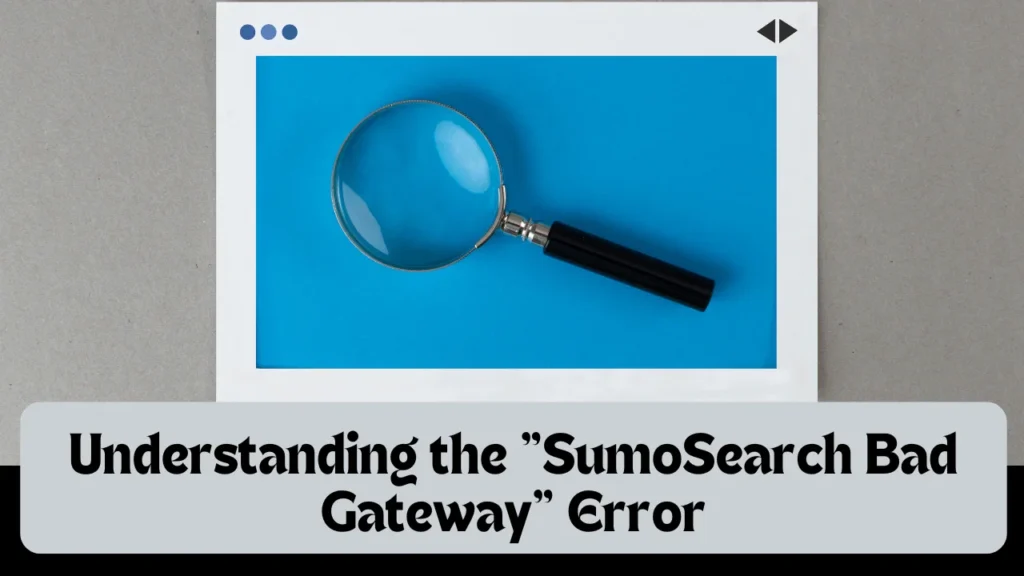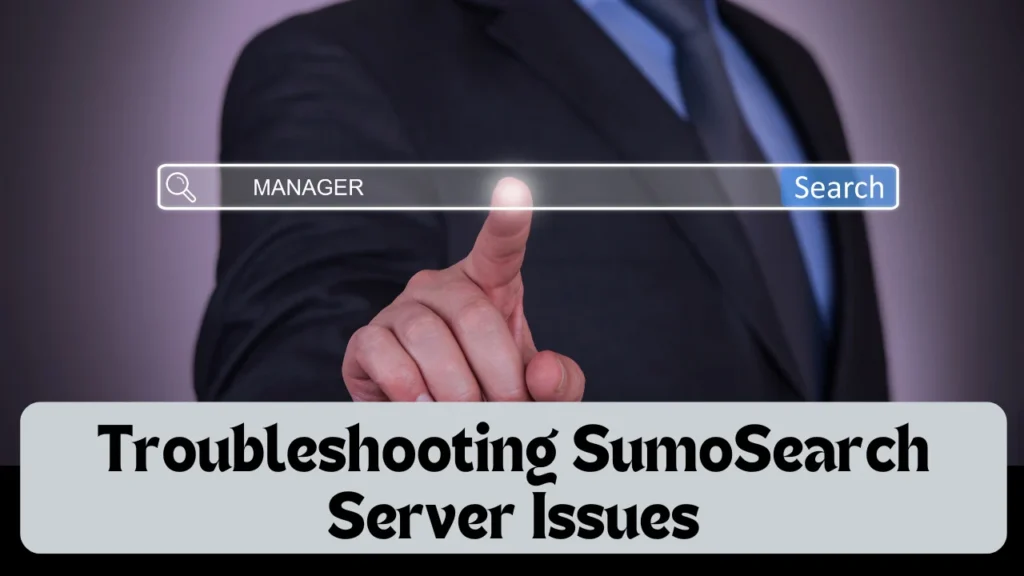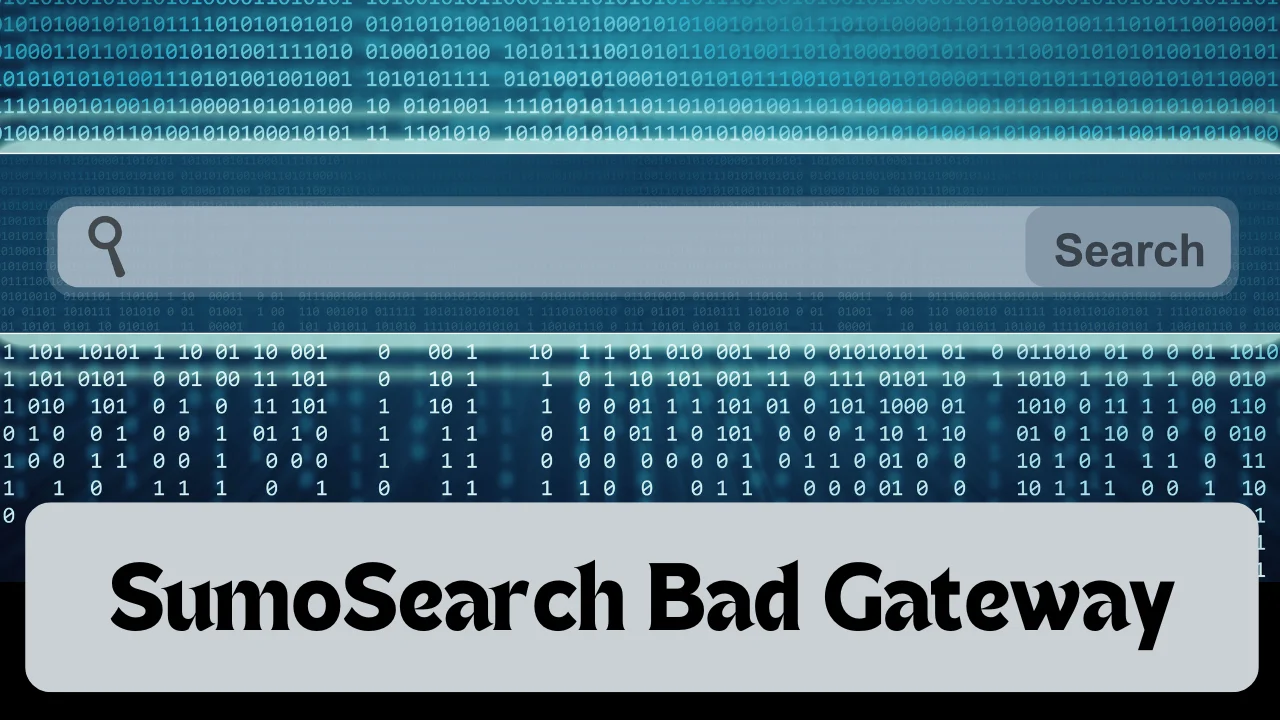When you’re depending on the platform to access critical information, encountering a “SumoSearch Bad Gateway” error can be incredibly frustrating. Commonly shown as a “502 Bad Gateway” message, this error signifies that the proxy or gateway server has received an incorrect response from the server upstream. As a result, you won’t be able to access the webpage you were trying to view.
This article will define SumoSearch, explain why the “Bad Gateway” error happens, and provide solutions for administrators and users alike. Also covered will be how this mistake affected the user experience and how to stop it from happening again.
What is SumoSearch?
The comprehensive indexing of online resources is one reason for the rise in popularity of SumoSearch, an advanced search engine platform. With SumoSearch’s extensive database, finding academic articles, niche websites, or specific data has never been easier. Even SumoSearch can experience technical difficulties, such as the “502 Bad Gateway” error, just like any other web-based platform.
Why SumoSearch Matters?

SumoSearch’s powerful indexing capabilities have made it a popular tool for researchers, professionals, and regular users. Users can take advantage of its simplified and efficient method of searching the web for information. Those in need of fast and trustworthy search results have found the platform indispensable due to its capacity to compile data from multiple sources and display it in an easy-to-understand format.
On the other hand, the “Bad Gateway” error can severely limit the user’s experience when it happens. In order to keep the platform trustworthy and user-friendly, it is crucial to identify what causes this error and fix it.
Understanding the “SumoSearch Bad Gateway” Error

Server Overload
The “SumoSearch Bad Gateway” error often occurs when servers are overloaded. This happens when the server is overwhelmed with simultaneous requests from too many users attempting to use SumoSearch. The 502 error happens when the server is overwhelmed and returns an incorrect response.
Network Configuration Issues
An additional cause of the “Bad Gateway” error in SumoSearch could be incorrectly configured network settings. Incorrect DNS settings, IP address conflicts, or firewall rules could be to blame if the gateway server and the upstream server are unable to communicate properly. The 502 error is caused by these problems that interrupt the data flow.
Upstream Server Problems
When SumoSearch gets a 502 error, it usually means that the upstream server it uses is having problems. The “Bad Gateway” message can be triggered if the upstream server is unavailable, has high latency, or is incorrectly configured. This means that the gateway server may receive an invalid response. Even though this is usually just a temporary issue, server administrators still need to address it quickly.
Web Hosting Provider Issues
The web hosting service might be at blame on occasion. The “SumoSearch Bad Gateway” error might be caused by the hosting provider’s servers being down, doing maintenance, or having incorrect settings. To avoid these kinds of problems from impacting the user experience, it is essential to monitor hosting services regularly.
Impact on User Experience
The inability to access necessary information is exacerbated when users experience a “Bad Gateway” error on SumoSearch. Those who depend on the platform for searches that require immediate attention may find this particularly frustrating. If this issue is not resolved soon, users may lose faith in the platform.
How to Fix the SumoSearch Bad Gateway Error?

Refresh the Page
Reloading the page is the easiest and, in many cases, the best way to fix a “SumoSearch Bad Gateway” error. In some cases, the problem is just a temporary glitch, and you can fix it by refreshing the page. The server may provide the correct response the second time around if you do this.
Clear Browser Cache
Another possible source of 502 errors is a corrupted browser cache. If you suspect that data stored in the cache is causing problems with the server, clearing the cache will remove it. This should fix the “Bad Gateway” problem by updating your browser to the latest version of the page.
Try a Different Browser
If you are still seeing the “Bad Gateway” error, you might want to try using a different browser to access SumoSearch. Website-server communication can be disrupted by browser-specific problems like incompatible extensions or out-of-date versions. You might be able to access the site without getting the error if you switch to a different browser that doesn’t have these problems.
Check for Server Status
Verify the health of SumoSearch’s servers before you blame yourself. You can check SumoSearch’s social media pages or use one of the many available tools to see how the server is doing. Nothing will happen until the servers go online again if they are down.
Contact SumoSearch Support
You may need to get in touch with SumoSearch support if everything else doesn’t work. You can get detailed information about the error and their efforts to fix it from them. On occasion, they might provide situation-specific troubleshooting recommendations.
Troubleshooting SumoSearch Server Issues

Review Server Logs
The initial step for administrators in diagnosing a SumoSearch Login ‘Bad Gateway’ error is to review the server logs. If the error occurred because of an overload, a misconfiguration, or a problem with a server upstream, the logs will show exactly what happened at that moment.
Check Network Configurations
Verifying the accuracy of the network configurations is of paramount importance. The gateway server might be unable to communicate with upstream servers due to configuration issues, which would result in a 502 error. If the problem persists after that, try checking the firewall rules, IP addresses, and DNS settings again.
Monitor Server Load
The occurrence of “Bad Gateway” errors can be avoided by consistently keeping an eye on the server load. In order to prevent server overloads, administrators monitor request volume and performance metrics. You can also reduce the likelihood of this happening by optimizing server performance and implementing load balancing.
Ensure Upstream Server Functionality
Another important step is to make sure the upstream servers are working properly. That involves making sure they aren’t experiencing any downtime, misconfigurations, or latency that could impact how they respond to the gateway server. To keep these servers functioning properly, regular updates and maintenance are necessary.
Update Web Hosting Services
Service updates or upgrades may be in order if the problem is with the web host. To better suit SumoSearch’s needs, this may entail switching to a more dependable provider, increasing server capacity, or modifying hosting settings.
Preventing Future Bad Gateway Errors
Regular Server Maintenance
To avoid “SumoSearch Bad Gateway” errors, it is crucial to perform proactive server maintenance. This encompasses routine upgrades, fixes for security issues, and enhancements to performance. Maintaining optimal server performance reduces the likelihood of errors and guarantees a seamless user experience.
Load Balancing Solutions
Distributing traffic evenly across servers through load balancing solutions helps prevent overload and reduces the likelihood of 502 errors. This guarantees that the server will be able to handle requests without problems even during periods of high usage.
Improved Network Configurations
Another way to avoid “Bad Gateway” errors is to review and improve your network configurations on a regular basis. Making sure IP addresses are assigned correctly, configuring firewalls so servers can communicate properly, and optimizing DNS settings are all part of this process.
Upstream Server Monitoring
It is also important to keep an eye on upstream servers to make sure they aren’t experiencing any performance problems, latency, or outages. Administrators can stop possible issues from becoming 502 errors by finding them early and fixing them.
Enhanced Web Hosting Services
Lastly, SumoSearch can benefit from a more solid foundation by upgrading its web hosting services. Among these options are dedicated servers, more bandwidth, or a different provider with better uptime assurances.
FAQs
What causes a 502 Bad Gateway error on SumoSearch?
A 502 Bad Gateway error on SumoSearch typically occurs when the gateway server receives an invalid response from an upstream server. This can be due to server overload, misconfigured network settings, or issues with the web hosting provider.
How can I fix the SumoSearch Bad Gateway error?
To fix a SumoSearch Bad Gateway error, try refreshing the page, clearing your browser cache, or using a different browser. If the issue persists, check the server status or contact SumoSearch support for assistance.
Is the SumoSearch Bad Gateway error common?
While not exceedingly common, 502 errors can occur on any web-based platform, including SumoSearch. Regular maintenance and monitoring can help reduce the frequency of these errors.
Can I prevent the SumoSearch Bad Gateway error from occurring?
As a user, there is little you can do to prevent this error. However, website administrators can take steps such as regular server maintenance, load balancing, and improved network configurations to minimize the occurrence of 502 errors.
How long does it take to fix the SumoSearch Bad Gateway error?
The time required to fix a SumoSearch Bad Gateway error can vary depending on the root cause. Simple issues might be resolved in minutes, while more complex server problems could take longer to address.
Conclusion
Ultimately, it’s important to know what causes the SumoSearch Bad Gateway error and how to fix it so you can have a much better experience overall. Users and administrators alike can help keep SumoSearch running smoothly and reliably by following the troubleshooting and preventative steps provided. This will keep the platform secure and earn users’ trust.

Jennifer Forster is a skilled writer at Explainervilla.com, where she covers a wide range of topics such as technology, lifestyle, and culture. Her work emphasizes how contemporary trends intersect with traditional values, breaking down complex innovations and sustainability initiatives into easy-to-understand insights.
